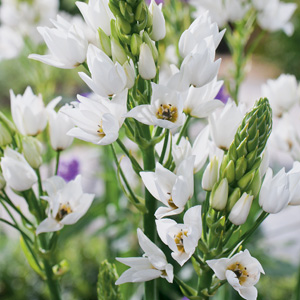Chincherinchee Growing Guide

What is Chincherinchee?
Chincherinchee (Ornithogalum thyrsoides) are a bulbous perennial. They are from the Hyacinthaceae family which is native to South Africa. During Spring bright green semi erect strappy foliage starts to emerge forming a clump. Late Spring is when the flowers begin to appear. Flowers are arranged on spikes of up to 30 white cup shaped flowers. Don’t be concerned if the foliage starts to die back when the flowers begin to emerge because this can some times happen. The plant will die down to ground level in late Autumn to Winter for its dormant time. In Spring it will reshoot again. Chincherinchee are a fast multiplying bulb. They prefer a full sun position in well drained soil and are drought hardy once established.
Benefits of Growing Chincherinchee
Chincherinchee are ideal for garden borders and pots. They multiply quickly and look good en masse. Chincherinchee make ideal as a cut flower as they have a long vase life.
How to Grow Chincherinchee
Climatic Zones
Suitable for most climates except tropical and semi-arid.
Plant Size
Height: 50-60m, Width: 10-20cm
When To Plant Chincherinchee
Plant in Autumn
Soil Preparation
Prefers a well drained but not very rich soil. Turn over soil before planting, incorporate some complete fertiliser.
How To Plant Chincherinchee
Plant in full sun, 10cm apart with the bulb at a depth of 8cm under the soil.
Chincherinchee Plant Care
Chincherinchee will benefit from an occasional deep watering during the growing season.
Although fertilising is not essential it would certainly be beneficial to apply a complete fertiliser during the growth period, this will encourage the plant to produce better blooms.
They can be left undisturbed for many years. Chincherinchee only need to be lifted and divided when very crowded.
Generally a trouble free bulb, however it is susceptible to a fungal disease, which may occur during cool, showery weather. A fungicide may be required in this case.
Cut spent flower stems to ground level. The foliage should be left until the plant dies down, as this feeds the next years growth.







